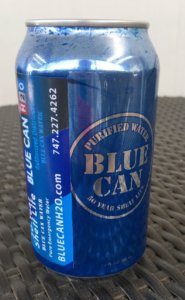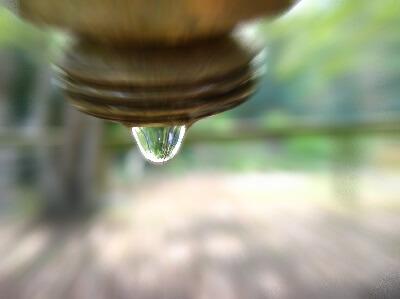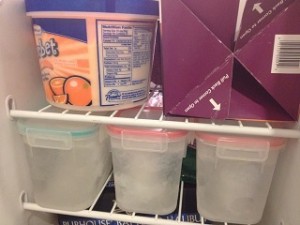Store Water for Emergencies — Revived

You have surely read many articles about why and how to store water for emergencies. The picture above came from one of our own earlier Advisories! But with hurricane season starting, an a tornado having just hit last week, it’s time once again to address this most important preparedness topic.
If some of this looks familiar, please jump to the bottom half of the Advisory where we address Buckets, bladders and bags! All new!
Why is storing water so difficult? Consider these possibilities:
- Your household changes. What you needed to survive for 10 days a couple of months ago won’t be enough with the new baby plus your mother now living with you.
- You move to a new home in a new location with a totally different climate. You used to be near the Washington coast. Now you’re in the middle of Oklahoma.
- Another hurricane is threatening off the coast. Its storm surge will overrun your municipal water system — again.
- Carcinogens and toxic contaminants have been discovered in the drinking water in your state.
The point? You can’t just check the box one time and be done with it! Having enough water in the right place at the right time is an ongoing challenge.
So, time for another look at how best to store water for emergencies.
Plastic bottles of water? Handy but . . . maybe not!!
Here’s another photo from my own camera. The bottle is from a case of water that has been sitting in our HOA office for about a year.

Plastic bottles are NOT a good idea for long-term, emergency storage. (Not to mention the issue of plastic waste . . .) Plastic doesn’t stand up to weight or to heat. And that heat issue makes them particularly impractical for storage in the car.
On the other hand, high-quality BPA free plastic containers DO work for longer-term storage.
The following examples of storage containers come from Amazon. As an Amazon Associate I earn a commission if you make a purchase through these links.
WaterBricks –In the past we’ve talked about WaterBricks – relatively expensive but of excellent quality and extraordinarily useful for apartments and condos where storage space is limited. They stack and fasten together for stability. The full-sized brick holds 3.5 gallons; the half-size holds 1.6 gallons. You can also get a spigot for a brick, so you could set it up on a counter for real dispensing convenience. (I’d get more than one spigot.)

Last time I checked at Amazon, the WaterBricks were on back order. I soon discovered Saratoga Farms, another stackable container set, slightly different but just as useful. It’s “blocks” hold 5 gallons each.

Plastic containers for ice. Don’t forget to fill smaller-sized clean plastic containers with water and use them to keep your freezer tightly packed. (Be sure to leave plenty of space for the water to expand. And avoid containers marked “3” (for polyvinyl chloride, or PVC), “6” (for polystyrene, or PS), and “7” (for polycarbonate). Frozen plastic “cubes” will help save energy by maintaining the cold in the freezer, and if the power goes out they’ll give frozen foods a bit of a longer life. Finally, you can use the melted ice as a source of emergency water – for hygiene if not for drinking. (Once-frozen water sometimes doesn’t taste so good.)

It’s probably best to recycle the water in your WaterBricks and your food storage containers every 6 months or so.
Aluminum cans – Good for 50 years!
Last year Joe and I participated in an Emergency Preparedness Forum north of Los Angeles and there we were introduced to canned water. Here’s a picture of one of our cans. You can buy cases of the stuff, easy to store. And here’s the most exciting thing – the water has a 50-year shelf life!

As you can image, these aluminum cans are relatively expensive. You can get them at Amazon – and they will be delivered. Here’s the link:
If you live in or near California, you may be able to get discounted prices on cases of Blue Can Water from my friend Patty Kirby. She introduced me to canned water, and she works with HOAs, businesses and other groups. (Obviously, an order big enough to fill a pallet (100 cases) would get the best possible shipping price.) Contact Patty directly: patty@BlueCanH2O.com
Water Barrels – Good for at least a year and probably twice that long!
Quite a few years ago we got a great deal on blue barrels for our volunteers. These days prices are considerably higher, but the need to store water for emergencies is still there, and maybe even greater. In fact, you may need more water than you did before!

Some thoughts to remember when it comes to water barrels:
- When it’s full, the barrel weighs about 480 pounds. So – how are you going to get the full barrel to where you can use it? Not easily! That’s why you need a pump to get out a gallon or two at a time.
- Be sure your barrel is of food-grade plastic. Give it a good clean by adding a couple of gallons of water, a cup of fresh chlorine bleach , and rolling it around until every surface has been exposed. Drain and rinse.
- Find a good place to set the barrel because that’s where it’s going to remain once it’s filled. Keep it out of direct sunlight. Don’t place it directly on a concrete floor – put some boards down as a platform. And you may consider how to camouflage it. No use broadcasting that you have a lot of water available.
- Once your barrel is clean, fill it with tap water as is. (Make sure the hose isn’t dirty!) But you may wish to add another layer of protection by treating the water you are storing with bleach or water purifier. The water storage recipe: add 6 teaspoons of fresh, regular unscented bleach to your 55 gal. barrel of water.
NEW: Buckets, bladders and bags to fill at the last possible minute.
Recently one of my LinkedIn groups was filled with water storage ideas. Here are several more containers for you to consider, based on recommendations from that group. Consider how HEAVY the various containers will be once they are filled with water! 1 gallon (in its container) weighs about 8 1/2 pounds.
(So the 2-gallon bag Joe is holding in the picture above weighs about 17 pounds.)
 | We own a couple of these, and have them tucked into our survival kits. Probably not too durable, but they have held up for us. Certainly convenient! Stansport 2-Gallon Water Storage Bag |
 | If your container doesn't have a spigot, consider how you are going to get the water out. This one has a spigot. WaterStorageCube BPA-Free Collapsible Water Container 5.3 Gallon with Spigot, Camping Water Storage Carrier Jug for Outdoors Hiking Hurricane Emergency, Foldable Portable FDA Water Canteen (1-Pack) |
 | Rigid container, bigger yet. Gets excellent reviews. Reliance Products Aqua-Tainer 7 Gallon Rigid Water Container |
 | This is a one-gallon collapsible container, which makes it easy to store until you want to fill it. 4-Pack Bundle | Reusable Transport and Storage Water Container Solution | 1-Gallon | Collapsible | Non-Toxic BPA-Free | Space Saver Solution | Proven no leaks |
 | Comes in a variety of colors, and has a lid. Freegrace Premium Collapsible Bucket Compact Portable Folding Water Container - Lightweight & Durable - Includes Handy Tool Mesh Pocket (Green(Upgraded), 23L (Lid)) |
 | Efficient. BIG when filled! (Bad illustration. Click below to get the full "picture.") AQUATANK2 Water Storage Bladder (60 Gallon) |
 | Another poor image for a dramatic piece of equipment. Power outage threatened? Lay the liner in any standard bathtub, attach the fill sock to the faucet, and fill the bladder to capacity, which takes approximately 20 minutes. A siphon pump is included to easily dispense the water into jugs or pitchers, making it easy to use your water every day. WaterBOB Bathtub Emergency Water Storage Container, Drinking Water Storage, Hurricane Survival, BPA-Free (100 Gallon) (1) |
I encourage you to get some containers like those above. Knowing that you have what you need when the emergency threatens will give you greater peace of mind. And you’ll have some credibility when you remind neighbors that they should be ready or already storing water, too!
Let us know if YOU have a favorite water storage container.
Virginia
Your Emergency Plan Guide Team










